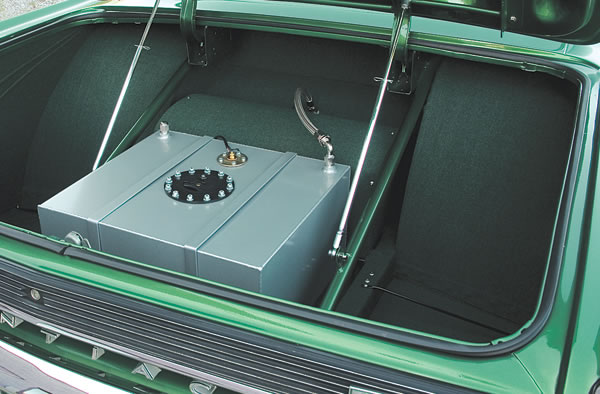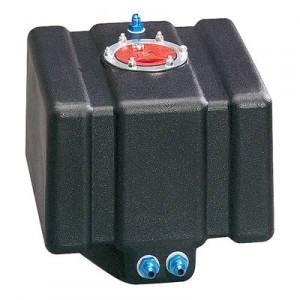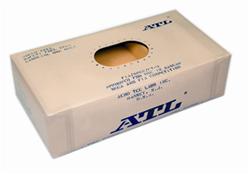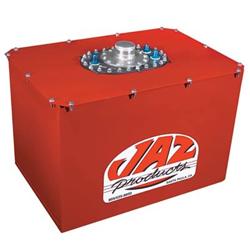Some safety items are designed to protect you in case of a fire: fire suits, fire extinguishers, etc.
A fuel cell is designed to prevent automotive fires altogether, making it one of the most-important pieces of safety equipment you’ll ever choose. As such, we thought it might be a good idea to provide you some tips for choosing the right fuel cell for your application. Designed primarily for (but not limited to) racing applications, a fuel cell typically has a higher burst strength than a factory-type fuel tank. They’re also often equipped with features like rollover valves to prevent spilling in case your vehicle rolls over during an accident.
According to the fuel cell experts at Jaz Products and ATL (Aero Tec Laboratories) Fuel Cells, here are some important considerations to make sure you find the right fuel cell for your vehicle:

Race or No Race?
The first question is: What is the intended purpose of your vehicle?

If you’re putting your fuel cell in a street rod or street-driven vehicle, you can choose pretty much any type of construction and it’s going to provide an improvement over most factory tanks. It simply comes down to your budget, space constraints, and preference on appearance. Plastic fuel cells are typically the most budget-friendly option; however, street rodders and other appearance-minded buyers often prefer the looks of steel or aluminum fuel cells over plastic. Whichever style you choose, you’ll have to keep the amount of available space in mind and choose your fuel cell accordingly.
If you’re choosing a fuel cell for racing purposes, there are a few other things you’ll need to take into consideration, including sanctioning body and fuel type.
Sanctioning Body
Depending on your race sanctioning body, you’ll likely have rules on things like fuel cell materials, capacity, and mounting techniques. For example, NASCAR is very specific on what gauge (thickness) of steel must be used for the fuel cell container. NHRA mandates that fuel cells outside the body of the vehicle must be enclosed in a steel tube frame and all fuel tanks must be isolated from the driver’s compartment by a firewall. The point is each sanctioning body has different safety rules, and you’ll want to consult your rule book to make sure you conform to these regulations.
In a general sense, plastic fuel cells are a common choice for drag racing use. Jaz Products, for example, says most of its polyethylene fuel cells exceed SFI specs and are NHRA accepted. You can also find steel or aluminum fuel cells that are set up for drag racing, off-road competition, and circle track competition. However, some sanctioning bodies–FIA and NASCAR–specify fuel cells with some type of internal bladder. The types of materials used for these bladders have evolved over the years, and the exact material often comes down to our next consideration: fuel type.
Fuel Type

Standard plastic and rubber bladders were the norm when fuel cells were first developed. Now, you can find bladders in a variety of high-tech materials. When choosing a bladder material, you’ll want to make sure it’s compatible with the type of fuel you use. Here’s a look at some of the latest bladder materials used by ATL Fuel Cells, including fuel compatibility and intended purpose:
Molded Seamless Hard Rubber
Fuel Type: Hydrocarbons, methanol, ethanol
Popular Uses: All forms of motorsports
Safety Rating: FIA FT3
3-Layer Ballistic Fiber Soft Rubber
Fuel Type: Leaded and unleaded gas, E10, and high aromatics
Popular Uses: All forms of motorsports
Safety Rating: FIA, FT3
Heavy-Duty Ballistic Fiber
Fuel Type: Leaded and unleaded gas, E10, and high aromatics
Popular Uses: NASCAR East/West and Canadian Tire Series, ARCA, Whelen Mods
Safety Rating: NASCAR 2000, FIA FT3.5
Ultra-Thin Aramid Fiber (comparable to Kevlar)
Fuel Type: Aromatic hydrocarbons
Popular Uses: NASCAR East/West and Canadian Tire Series, ARCA
Safety Rating: NASCAR 2000, FIA FT3.5
Heavy-Duty Ballistic Reinforced Rubber
Fuel Type: Methanol and ethanol
Popular Uses: Dirt and Asphalt Sprint Cars, Midgets, Super Modifieds, Dirt Modifieds, and Hydroplanes
Safety Rating: FIA FT3 equivalent
Extreme-Duty Ballistic Aramid
Fuel Type: High aromatic hydrocarbons
Popular Uses: NASCAR Sprint Cup, Nationwide & Camping World, F1 Grand Prix, IMSA
Safety Rating: FIA FT5, SFI 32.1
Aramid (comparable to Kevlar) Reinforced Fluoropolymer
Fuel Type: All fuels, including gas, ethanol, methanol, diesel
Popular Uses: Exotic road cars, road racing, and circle track
Safety Rating: FIA FT3.5
Pickup Location
Whether you’re leaning toward a basic plastic fuel cell for the street or the latest bladder design for competition, you’ll want to consider pickup location. For example, fuel cells designed for circle track racing will often have the pickup located in the right rear corner–right where the fuel gravitates during the constant turning. Drag race fuel cells, on the other hand, will often come with a rear sump and rear-mounted pickup to accommodate hard launches. By considering pickup location, along with sump design and baffling, you can ensure that fuel is channeled right where it needs to go for your application.

Some fuel cells also include foam to prevent fuel sloshing, enhance fuel control, and slow spills or leaks. While these are great benefits, keep in mind that some foams are not compatible with ethanol, methanol, and other more exotic fuels.
Other Considerations
Other things to look for when choosing a fuel cell are the presence of a check valve. This type of valve, which prevents fuel from spilling when upside down, is required in many cases. You may also want to look for specific fitting sizes and sender ohm range.
To summarize, here are some of the important questions you’ll need to answer before ordering your full cell:
- What is the intended purpose of my vehicle?
- What type of fuel do I use?
- How much space do I have?
- Does my race sanctioning body (if applicable) have rules for materials and fuel capacity?
- What mounting rules does my sanctioning body (if applicable) specify?
- What safety specifications does my fuel cell need to meet?
Answer those questions, and you’ll be on your way to finding the right fuel cell for your vehicle.

are there any fuel tanks that are fireproof? i remember seeing a demo on fuel cells filled with spun aluminum or some other spun material that were subjected to open flame without bursting into flame
I am building drag strip only Fox Body Mustang. Am planning on running E85 with aprox 10 gal fuel cell located in hatchback area with bulkhead. Probably 10 to 11 sec car. What cell do you recommend?